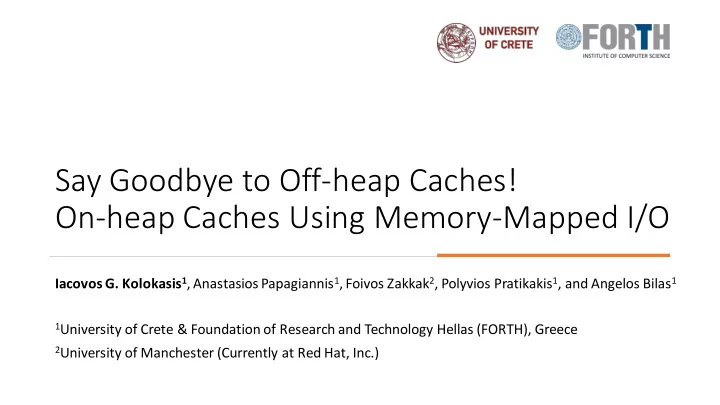

Say Goodbye to Off-heap Caches! On-heap Caches Using Memory-Mapped I/O Iacovos G. Kolokasis 1 , Anastasios Papagiannis 1 , Foivos Zakkak 2 , Polyvios Pratikakis 1 , and Angelos Bilas 1 1 University of Crete & Foundation of Research and Technology Hellas (FORTH), Greece 2 University of Manchester (Currently at Red Hat, Inc.)
Outline • Motivation • TeraCache design for multiple heaps with different properties • How we reduce GC time? • How we grow TeraCache over a device? • Evaluation • Conclusions 2
Increasing Memory Demands! 175ΖΒ • Big data systems cache large intermediate results in-memory 3x • Speed-up iterative workloads 50ΖΒ • Analytics datasets grow at a high rate • Today ~50ZB • By 2025 ~175ZB [Source: www.seagate.com | Seagate] • Big data systems request TBs of memory per server 3
Spark: Caching Impacts Performance • Jobs cache intermediate data in memory • Subsequent jobs reuse cached data 90% • Caching reduces execution time by orders of magnitude • Naively, caching data needs large heaps which implies a lot of DRAM 4
Caching Beyond Physical DRAM • DRAM capacity scaling reaches its limit [Mutlu-IMW 2013] • DRAM scales to GB / DIMM • DRAM capacity is limited by DIMM slots / servers • NVMe SSDs scale to TBs / PCIe slot at lower cost • Already Today: Spark uses off-heap store on fast devices 5
Between a Rock and a Hard Place! GC vs Serialization Overhead Executor Pros Cons Memory On-heap No Serialization High GC Execution Memory Storage Memory Cache (on-heap cache) Off-heap serialize/deserialize Low GC High Serialization Cache Executor Memory Execution Memory Disk Storage Memory (off-heap cache) (on-heap cache) Merge the benefits from both worlds! 6
Outline • Motivation • TeraCache design for multiple heaps with different properties • How we reduce GC time? • How we grow TeraCache over a device? • Evaluation • Conclusions 7
Different Heaps for Different Object Types • Analytics computations generate mainly two types of objects • Short-lived, ( runtime managed ) • Long-lived, similar life-time, ( application managed ) • JVM-heap on DRAM which is garbage collected • Locate short-lived objects • For computation usage (task memory usage) • TeraCache-heap which is never garbage collected • Contains group of similar life-span objects (e.g., cached data) • Grow over a storage device (no serialization) 8
Split Executor Memory In Two Heaps Executor Memory Execution Storage Memory Memory • JVM-heap ( GC ) TeraCache ( non-GC ) • JVM-heap (GC) TeraCache (non-GC) Organize TeraCache in regions • Bulk free: Similar life-time objects into the same region region0 . . . regionN • Dynamic size We make the JVM aware of cached data • Spark notifies JVM • Finds the transitive closure of the object JVM-heap Tera-heap • Move and migrate object into a region 9
We Preserve JAVA Memory Safety Region Region Region New Gen Old Gen TeraCache-heap (no GC) JVM-heap (GC) Avoid pointer corruption between objects in two heaps No backward pointers: TeraCache → JVM- heap • Stop GC to reclaim objects used by TeraCache objects • Move transitive closure of the object 10
We Preserve JAVA Memory Safety Region Region Region New Gen Old Gen TeraCache-heap (no GC) JVM-heap (GC) Avoid pointer corruption between objects in two heaps No backward pointers: TeraCache → JVM- heap • Stop GC to reclaim objects used by TeraCache objects • Move transitive closure of the object Allow forward pointers: JVM-heap → TeraCache • But stop GC to traverse TeraCache Allow internal pointers: TeraCache ↔ TeraCache 11
Outline • Motivation • TeraCache design for multiple heaps with different properties • How we reduce GC time? • How we grow TeraCache over a device? • Evaluation • Conclusions 12
Dividing DRAM Between Heaps Executor Execution Memory Storage Memory Memory JVM JVM- Ηeap TeraCache Heap DRAM DR1 DR2 mmap() How to deal with DRAM resources? Iterative Jobs → reuse cache data → need large DR2 size • NVMe SSD Shuffle Jobs → short-lived data → need large DR1 size • 13
Deal With DRAM Resources For Multi-Heaps • KM-jobs produce more short-lived data • More minor GCs/s →more space for DR1 3x 2x • LR-jobs reuse large size of cached data • More page faults/s → more space for DR2 • We propose dynamic resizing of DR1, DR2 • Based on page fault rate in MMIO • Based on Minor GCs 14
Outline • Motivation • TeraCache design for multiple heaps with different properties • How we reduce GC time? • How we grow TeraCache over a device? • Evaluation • Conclusions 15
Prototype Implementation • We implement an early prototype of TeraCache based on ParallelGC • Place New generation on DRAM • Place Old generation on the fast storage device • Explicitly disable GC on Old generation • Evaluate • GC overhead • Serialization overhead • Not support for reclamation of cached RDDs and dynamic resizing 16
Preliminary Evaluation 2x 50% 37% • TC improves performance up to 37% • TC improves GC up to 50% LGR LR (on average 25%) (on average 46%) • TC improves performance up to 2x compared to Linux swap (LR) 17
Conclusions • TeraCache: A JVM/Spark co-design • Able to support very large heaps • Reduces GC time using two heaps • Eliminates serialization-deserialization • Dynamic sharing of DRAM resources across heaps • Improves Spark ML workloads performance by 25% on average • Applicable to other analytics runtimes 18
Contact Iacovos G. Kolokasis kolokasis@ics.forth.gr www.csd.uoc.gr/~kolokasis Institute of Computer Science (ICS) Foundation of Research and Technology (FORTH) - Hellas • • • Department of Computer Science, University of Crete 19
Recommend
More recommend